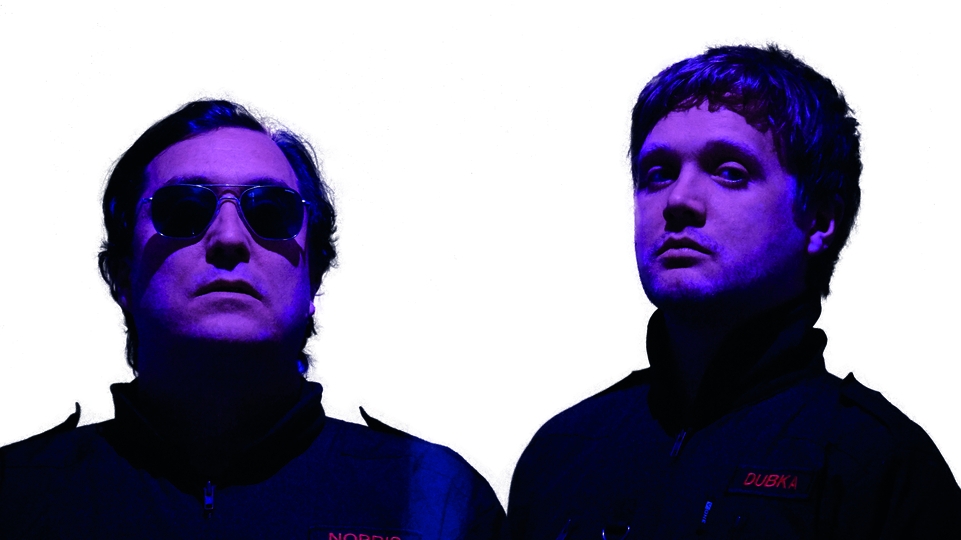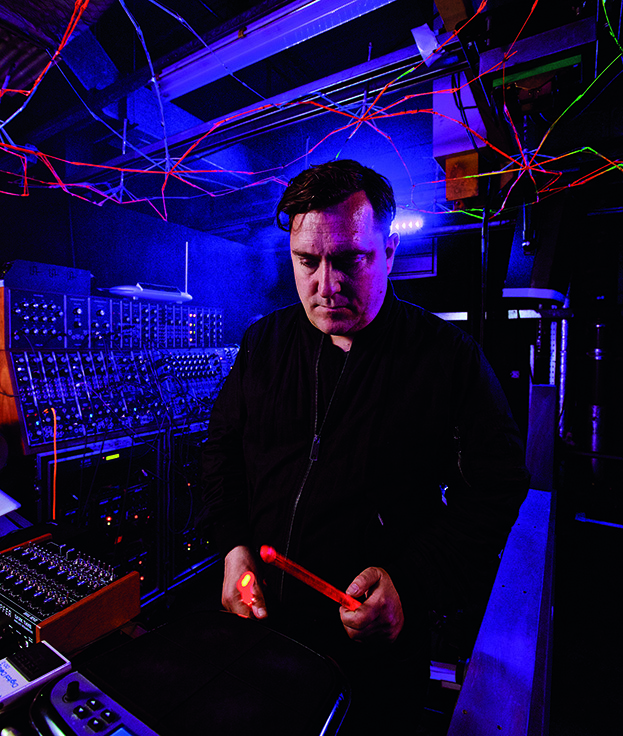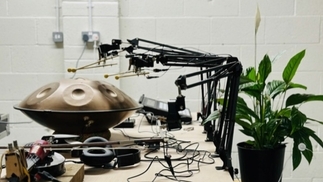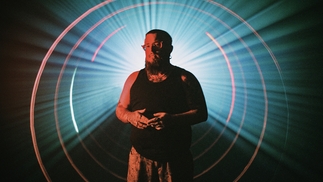SKY’S THE LIMIT: DJ MAG MEETS CIRCLE SKY
After a close encounter in a techno-themed Death Star, Richard Norris and Martin Dubka’s project Circle Sky was born...

WORDS: Declan McGlynn
PICS: Richard Stow
Duos are nothing new to Richard Norris. As one half of the hugely successful ’90s act The Grid, he smashed the pop charts both in the UK and internationally. Later, he teamed up with one of the UK’s most in-demand DJs Erol Alkan to form the psychedelic party-starters Beyond The Wizard’s Sleeve, who’ve lent their remix skills to the likes of Simian Mobile Disco, Goldfrapp and the Chemical Brothers.
While touring internationally with Daft Punk as part of Kitsuné-signed Cazals and later working the board for artists such as Ali Love and Tyson, Martin Dubka was masterminding a distinctive live project. Using only a modular synthesizer — no laptop, backing track or instruments — Dubka creates new, original, unrehearsed material from scratch in front of the unsuspecting dancefloor.
It was during one of these unique live shows that the two originally met. “I booked Martin for a club-night I was running and thought what he was doing was amazing,” Richard explains. “Using a modular synth to sound like a DJ set or a full track and making it all up on the spot is a startling achievement. I thought it would be good to add more hardware and sampler-based elements so you could have more recognisable jumping-off points, as well as the more freeform parts.”
STAR QUALITY
A few months later, Richard was booked to perform at Secret Cinema’s epic all-encompassing Star Wars movie experience. It was his job to play brooding techno inside a hidden Death Star replica that only dedicated ravers found their way in to. When they did, they were met with the colossal sound of the legendary Moog synthesizer. “Moog had lent Secret Cinema a load of equipment to do the gig and they let us record whatever we wanted, so we’d go in and write all day. If we wanted to hear what it might sound like in a club, we’d just put it on the huge PA in the Death Star.”
Martin joined Richard for the final weeks of the project and each night, the duo would improvise and jam on some of the best synthesizers money can buy. Richard recalls: “You’d have 1500 people all dressed in Star Wars outfits dancing to random analogue techno. It was a really strange experience! It wasn’t advertised and no one knew who we were and just accepted it as part of Secret Cinema, so it was a great boot camp for us.”
Playing anonymously six nights a week in an East London-based Death Star allowed the two to develop an intuitive connection, something Martin Dubka had never anticipated. “When I was playing by myself on my modular, I never wished for anyone else because I didn’t know what they might do, but I did always wish I could do more,” he tells DJ Mag. “Now, I’ll know that Richard’s taking care of the main part of the track, so I can just go and play a chord.
That’s a massive deal for me — I’d never been able to do something even that simple on my own modular set-up, as I’d been controlling the whole show alone. In some ways it’s actually harder to play with someone else — there’s a whole layer of communication and telepathy that you need to have. Luckily, we had three weeks to develop that.”

ON REPEAT
Despite the almost endless selection of sonic possibilities offered by the group’s equipment, Circle Sky subscribe to one of club music’s most sacred mantras: repetition. “It’s repetition, but it’s not repetitive — it’s always slightly moving.
If you listen to things like ‘E2-E4’ [awesome long minimialist electronic track by Manual Göttsching], you don’t get bored of that record — there’s something evolving or changing subtly over time,” explains Richard. “You get that in really good spacious house and techno; artists like Carl Craig. I remember seeing him at Sonar and when a hi-hat came in, the whole audience cheered. To use subtle changes to great affect is the goal for us.”
Another creed of the club is simplicity — ‘stripped-back’ and ‘less is more’ are dance music clichés for a reason — but it’s not as simple as it sounds. “Listening to the tracks that we finished that we’re going to put out, it’s taken me quite a long time to get my head around how to make them sound simple,” Richard continues. “After spending years remixing, it’s so easy to keep adding and adding things to the music, which you think are creating more dynamics. I listen to it now and I think, ‘Why did I want to add more?’ but it’s very natural to do just because you can.”
Martin adds: “You’ve got to have good ingredients that stand on their own. It’s very easy to have a sub-standard component that you have to dress up but if you’ve got the right sound from the beginning, things can write themselves.”
There were over 30 tracks recorded during the Death Star Sessions — two of which are hitting shops on April 16th, known to Earthlings as Record Store Day. The double A-side features ‘Interstellar’ and ‘Reveal’, two tracks that almost define Circle Sky’s live aesthetic. ‘Interstellar’ evolves from haunting chords to reveal an acid-soaked bassline, all underpinned by a relentless and driving arpeggiator.
Clocking in at just under 11 minutes and with the desolate chords never too far away, it’s an uneasy listen that anxiously reflects the unknowns of the universe. ‘Reveal’ is equally dark, combining all that’s exhilarating and unpredictable about live electronic performance unraveling with a more structured, musical spine. Both, however, hold nothing back, and we echo Richard’s longing to “stretch it out more on a proper club soundsystem”. That will be something special.
MAN MACHINE
The machines might be generating the high-quality ingredients, but it’s the humans who are giving Circle Sky its soul. As so much electronic music is now made with a computer and a mouse, Richard explains the benefits of getting hands-on with the equipment: “Standing up and playing things by hand, your mind and your body work in different ways,” he says. “You create music that’s more live and has a more human feel.”
It’s that human feel that’s so important to the duo — so much so that only half of the set-list is planned in advance, meaning that no two Circle Sky shows will ever be the same. Creating unique experiences is key to Richard’s approach.
“There’s definitely something about what we do and why we keep it at least fifty-percent freestyle,” he says. “It means you want to be there on the night, and if you came again the next night it’d be different. We really like that idea. You can experience that to an extent with a DJ set but it’s not the same.”

RENAISSANCE MEN
There’s no doubt that Circle Sky’s formation comes as live electronic music reaches a renaissance. New equipment is either being incorporated into or completely defining live shows from artists like KiNK, Matador and Disclosure.
As the discussion turns to what triggered this third coming, Richard’s theory is a financial one: “The live electronic renaissance is partly because of economics — there’s so much good kit coming out that’s affordable. Creativity always seems to happen when you can get the kit for a good price. When the first house music producers got the 909 second-hand, when samplers became affordable, electronic music changed indelibly.
“I can’t wait for the next wave of Leftfield, Orbital, Chemical Brothers live acts, and there’s so much quality out there now that it should happen,” he continues. “People taking drum machines into the DJ booth is one thing, but I’d like to see full electronic bands with their own identity. It reminds me of the post-punk era when suddenly you could make 500 seven-inch singles for £300 and all these great records came out. Loads of terrible ones came out too, but loads of great ones that wouldn’t have come out otherwise because they couldn’t get a major deal. That created Joy Division, New Order etc — loads of bands and interesting records.”
FLYING SOLO
From the flight suits to the future-retro live visuals, the track titles and the custom-made patches for the crew, Circle Sky’s cosmic theme is never too far away. DJ Mag wonders where the concept originated and why they feel mystery and intrigue has all but disappeared from the club.
“We’ve got a real fascination with space and space-flight,” Martin explains. “We’re researching how we can incorporate that element more into the sound. Having a concept is what interests us. With no disrespect to a solo artist who is making records under their own name, they’re sort of little islands. Once you discover and fall in love with their music, what happens next? What do you look at? What else do you learn? The actual sounds on the record are only one part of music — it’s entertainment, it’s pop culture, it’s visual. If I really loved someone’s music, I want there to be a whole world behind it that I can explore after I’ve enjoyed it for what it is.”
“You take it for granted because good bands have that anyway,” Martin continues. “One; they’re already a gang that you’re not part of, so that’s its own world already. Then invariably they look like something — if you like The Ramones you buy a leather jacket, some Levi’s and some Converse and you’re delving into their world. There’s something to get your teeth into. If you have one guy who’s made one club track, it’s just a track. It’s so much more fulfilling for the fans and the artists when there’s more to it. David Bowie being in a jump-suit with a lightening bolt across his face adds something to the already fantastic song.”
Richard agrees. “It’s not as if electronic bands haven’t done that — Kraftwerk, Human League, there are many bands who’ve got an amazing identity. But I don’t know why it’s so few and far between [in dance music]. DJ culture has evolved to become a cycle of making records to get booked to do bigger DJ gigs, whereas we see the recorded music, the image, the live show and the concept all as equally important. It’s all part of the world we’re trying to create. Everything down to our nametags on the back of our flight suits — the audience can’t even see them, but they’re there.”
SPACE
With the blessings of the Moog synthesizer gods on their shoulders, years of experience as chart-topping artists, underground producers and DJs as well as touring the world, Circle Sky are in no rush to complete their mission. Richard has fairly modest ambitions for the duo. “We’re trying to do it all at a reasonable pace,” he tells DJ Mag. “We started by doing weeks of underground preparation when no-one knew who we were, and now we’re self-releasing our own 12-inch. We’d like it to build and build as naturally as possible. That, and we’d like to be the first band to play in space.”
Seems fair. Given Martin’s varied track record of professional bassist, record producer, mix engineer, remixer and modular synth designer, it’s no surprise that his hunt for innovation shows no sign of stopping. “Ultimately I always want to do interesting things that I wish existed but don’t,” he says. “Circle Sky is another one of those things. I think if you come across something you wish you could experience as a music fan and if you happen to be in a position to make it, then you should.”
Whether you put it down to the galactic concept, the towering equipment or simply the combined talents of two exceptional musicians, Circle Sky’s appeal is undeniable. With a collection of festival bookings already in the bag, they’re an act made for the 3am dance tent proverbial journey. They know, because they’ve been on it, as Martin explains: “That moment where everything locks in and it’s exciting and you look at each other and you feel it happening with everyone in the room. You can’t premeditate that. At that point you feel alive. That’s the absolute reason for doing it.”





